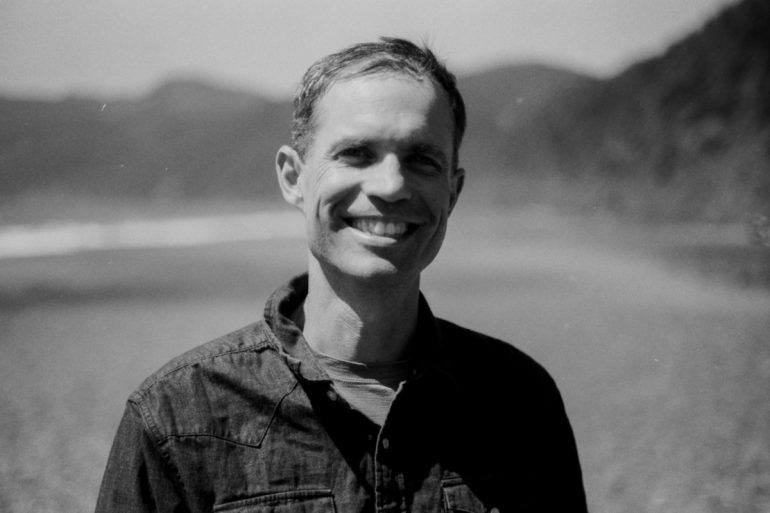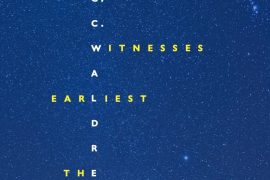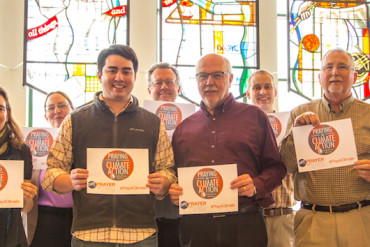Fred Bahnson is the author of Soil and Sacrament (Simon & Schuster) and co-author with Norman Wirzba of Making Peace With the Land (IVP). His essays have appeared in Harper’s, Orion, Emergence, The Sun, Image, Washington Post, and the anthologies Best American Spiritual Writing 2007, Best American Travel Writing 2020, and Wendell Berry & Religion. He is the recipient of a W.K. Kellogg Food & Society Fellowship, and an Artist Fellowship from the North Carolina Arts Council. With his family, Bahnson recently relocate to his hometown of Bozeman, Montana, where he is at work on a book about contemplative spirituality in the Anthropocene. We spoke during his drive across country.
Jason Myers: You write at length in the last chapter of Soil and Sacrament about Sabbath. I wonder if our current period of social distancing has affected your thinking about and practices of Sabbath?
Fred Bahnson: I was really drawn to the Jewish understanding and practice of Sabbath, and hadn’t experienced it until I went to Adamah farm, where I totally fell in love with it. I thought, why aren’t Christians doing this? Everyone at the farm takes 24 hours off. They turn off their phones, the wi-fi, they have a lingering meal with wine and dancing. Abraham Joshua Heschel’s book The Sabbath has been very influential on me. It’s short, lyrical, and has so much wisdom to share on how to keep Sabbath. It’s an experience that requires discipline and practice, embodiment. If it’s just an attitude and cognitive assent, it lacks meaning. I’ve fallen out of the habit and am motivated to get back to it. There’s something magical and mysterious to stopping your life one day a week. I gained that from my Jewish brothers and sisters. In terms of the forced Sabbath we’ve all been living through the past several months, there’s an element of gift to it. As horrible as this time has been for so many people, it’s also given many of us more time to be at home. More time with family. More time for prayer and reflection. I tend to think of my self-worth in terms of production, how much I’m writing. I’ve been working on a big essay that was due months ago. When the pandemic hit, my brain turned to mush, and I’m just now getting back into it. We are having to reckon with a forced Sabbath and how can we embrace it and slow down and have more time with those in our immediate vicinity. There have been so many sweet, tender, intimate family moments. Part of Sabbath is learning how to slow down in a culture that rewards us for speeding up. We can be quite happy with hours when nothing is expected, when there’s no need to be productive. That’s where the best art comes from and the best spiritual practices come from. When we put ourselves into those modes, there are ecological benefits to just being. Just resting in God. Great art and wisdom emerge out of a posture of inner humility and poverty. As much as we can carry that with us on the far side of this pandemic, that gives me some hope.
JM: You’re moving to Montana, and I’m wondering if you think of your geographic relocation as anachorēsis such as you discuss at the end of your essay “The Ecology of Prayer”? Talk to us about the places where you feel most alive, most likely to commune with God?
FB: I think of anachorēsis as a daily pattern. We need daily periods of withdrawal and engagement. The Benedictines have codified the alternating poles of solitude and community into the structure of their day. I’m drawn to that monastic rhythm of life. In my own family, we practice a period of silence in which we pray the Jesus Prayer together every morning. It’s a communal pause in our family rhythms where we stop and make space for silence, for listening to God. In terms of my vocational life, I’ve spent that past 8 years building a program at Wake Divinity. I feel good about what I’ve done there, but I’m finding the need to pull back from program building and focus on writing, my next book and longer writing projects, to have more time for solitude and contemplation.
I also think about those periods of engagement and withdrawal in terms of landscapes. Early in my life I experienced God most in wild places, mostly the mountains and rivers of southwest Montana. Then I moved East and began to develop an agrarian sensibility. I read Wendell Berry, Wes Jackson, Sir Albert Howard, Ellen Davis. I fell deep into the agrarian world and that has been so rich. At the same time, I’ve always hungered for the big, wild landscapes where my childhood religious formation took place. I grew up in an evangelical milieu. The faith I learned through growing up in evangelical church in Montana felt very disembodied. It didn’t give a a very compelling account for the world around us, and that felt like such a lack. Given how much of my early sensibility was shaped by wildness, by the greater Yellowstone ecosystem, I’m eager to go back into that landscape with new eyes, and to explore how we might bring some of that wildness into our cultivated human existence.
JM: For the last several years you’ve been teaching at Wake Forest Divinity School. What are your thoughts on the current state of theological education? What gives you hope? What concerns you?
FB: I jumped in with a lot of excitement and hope that I was going to make inroads in the Church in terms of an ecological sensibility. I don’t use the phrase Creation care because for too many people it sounds like extra credit Christianity. My motivating factor has been to help show that what I call “the ecological imagination”—which Pope Francis described so beautifully in his encyclical Laudato Sí—is central to Christian vocation. The myth that there’s a separation between humans and the natural world, that we can do whatever we want without consequences, has been widespread in a lot of churches and it’s done so much damage. For many people Creation care remains a largely cognitive exercise, and what we need to take on these big myths isn’t necessarily a better argument, it’s metanoia, in the New Testament sense of turning your life around. That often happens through embodied experience, of being in Creation. It also happens in contemplative prayer, which leads us beyond dualisms. In those moments we drop below our cognitive defenses. I think that’s where God works most powerfully in us. That’s why art is so necessary. That’s why direct experience in nature is so necessary.
The Food, Health, and Ecological Well-being Program U started was designed to train a new generation of religious leaders who understand the ecological imagination as being central to their vocation as Christian leaders, and in small and powerful ways, it has. But it’s only a start, and we’re up against powerful cultural forces in the church that don’t see this work as central. What’s been most successful has been helping to build a network and capacity among pastors and nonprofit leaders who are already doing the work, to see that they’re not alone. The courses we offer on ecology and theology count as electives, but they aren’t as central to the curriculum as I wish they were. If we are training religious leaders for the world we inhabit and are moving into, you can’t do that without taking into account the crises of the Anthropocene. But—how to say this gently?—the world of theological education hasn’t quite caught up with our ecological realities.
JM: You address the limitations of environmental activism in several of your recent essays. How do you think we can best address the various ecological crises that confront us? What role(s) do you think faith communities can and should have?
FB: We need activism, but we can’t only be activists. Activism has to arise out of service to a larger vision: the goodness of God’s Creation that we are called to love and nurture. If our primary stance is being against what the bad guys are doing, we end up neglecting our inner work. We adopt a militaristic mentality. There’s a certain activist approach that too easily adopts the metaphors of war. But that’s not the only way of challenging our social problems. I think of a writer like Barbara Holmes. She wrote about how the Civil Rights movement came out of a place of deep spiritual practice; it was grounded in prayer. I think that’s a weakness in our contemporary climate movement. There’s too little emphasis placed on the transformation of the individual doing the activism. I don’t mean to imply that climate change will be solved through individual choices. But we need a larger vision of transformation than just “take down the oil companies.” I think that’s why our indigenous brothers and sisters at Standing Rock offered a gift to us, because we saw their activism grounded in a larger cosmological vision in which human health couldn’t be separated from the health of the land. It’s not just against, but it’s being for something beautiful. I don’t think the climate movement has found a unifying voice. This is in part what draws me to the contemplative tradition, which encourages a non-dualistic way of looking at the world, and at one’s place in it.
JM: What books are speaking to you right now?
FB: I read the mystics, the church fathers and mothers. I find so much nourishment when I read the 7th century mystic St. Isaac of Syria on God’s overwhelming mercy. He wrote, “An elder was once asked ‘What is a compassionate heart?’ He replied, ‘It is a heart on fire for the whole of creation, for humanity, for the birds, for the animals, for demons and for all that exists.’” That’s a way of seeing the world that we need. Extending that mercy to the nonhuman world. I didn’t find that holistic vision in my American church-going experience. Instead, I found it buried in the Christian contemplative tradition. The more I read about it, the more I practice, the more I slowly glimpse what a non-dualistic, compassionate way of being in the world looks like. I claim no expertise, but I get glimpses and hunger for more. That sense of the indwelling presence. St. Isaac has an amazing collection called the Ascetical Homilies. It has an expansive, cosmological vision, while still being intimate. It’s a vision of overflowing love that God has for us and that we are called to have for the world. It’s ecological in scope, because it expands our dependence, our vision, our love beyond the human. Because so much of Christendom has lacked such a vision, we’ve ended up doing damage to ourselves, to others, and to God’s Creation. Coming back to Standing Rock, those are the kind of places Christians need to go just to observe and learn, to experience some humility.
I’ve learned much from my friend and colleague Nikki Cooley, the director of the tribal climate change program at Northern Arizona University in Flagstaff. She grew up speaking Diné/Navajo and didn’t speak English until age 8. She grew up with a profound sense of oneness with creation. Watching the way that she begins whatever she has to say with a blessing and acknowledgement of her place in the world is to me a beautiful example of embodied spirituality. We have a lot to learn from the original caretakers here in North America.
I also read a lot of poetry and fiction. One recent novel that moved me was Richard Powers’ The Overstory. He’s said in interviews that he’s not a religious person, but I found that to be a deeply spiritual book. He has a line in the book about nobody being convinced by an argument, it’s only through story that we will be changed. The modern theological project is so focused on the cognitive, on argument and thesis, to its detriment. Story is always going to have the upper hand on theology. Barry Lopez has a great line in his fable Crow and Weasel – “sometimes a person needs a story more than food to stay alive.” That’s why the Gospels come to us as narrative rather than a set of doctrines. I’m motivated to imitate that in my writing, to try to tell stories we need right now that somehow channel the bigger story of God’s love for the cosmos.





